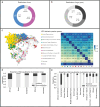This is a preprint.
GestaltMatcher Database - A global reference for facial phenotypic variability in rare human diseases
- PMID: 38903062
- PMCID: PMC11188141
- DOI: 10.21203/rs.3.rs-4438861/v1
GestaltMatcher Database - A global reference for facial phenotypic variability in rare human diseases
Abstract
The most important factor that complicates the work of dysmorphologists is the significant phenotypic variability of the human face. Next-Generation Phenotyping (NGP) tools that assist clinicians with recognizing characteristic syndromic patterns are particularly challenged when confronted with patients from populations different from their training data. To that end, we systematically analyzed the impact of genetic ancestry on facial dysmorphism. For that purpose, we established the GestaltMatcher Database (GMDB) as a reference dataset for medical images of patients with rare genetic disorders from around the world. We collected 10,980 frontal facial images - more than a quarter previously unpublished - from 8,346 patients, representing 581 rare disorders. Although the predominant ancestry is still European (67%), data from underrepresented populations have been increased considerably via global collaborations (19% Asian and 7% African). This includes previously unpublished reports for more than 40% of the African patients. The NGP analysis on this diverse dataset revealed characteristic performance differences depending on the composition of training and test sets corresponding to genetic relatedness. For clinical use of NGP, incorporating non-European patients resulted in a profound enhancement of GestaltMatcher performance. The top-5 accuracy rate increased by +11.29%. Importantly, this improvement in delineating the correct disorder from a facial portrait was achieved without decreasing the performance on European patients. By design, GMDB complies with the FAIR principles by rendering the curated medical data findable, accessible, interoperable, and reusable. This means GMDB can also serve as data for training and benchmarking. In summary, our study on facial dysmorphism on a global sample revealed a considerable cross ancestral phenotypic variability confounding NGP that should be counteracted by international efforts for increasing data diversity. GMDB will serve as a vital reference database for clinicians and a transparent training set for advancing NGP technology.
Figures





References
-
- Tekendo-Ngongang C. et al. Rubinstein-Taybi syndrome in diverse populations. Am. J. Med. Genet. A 182, 2939–2950 (2020). - PubMed
-
- Kruszka P., Tekendo-Ngongang C. & Muenke M. Diversity and dysmorphology. Curr. Opin. Pediatr. 31, 702–707 (2019). - PubMed
-
- Hadj-Rabia S. et al. Automatic recognition of the XLHED phenotype from facial images. Am. J. Med. Genet. A 173, 2408–2414 (2017). - PubMed
Publication types
Grants and funding
LinkOut - more resources
Full Text Sources

